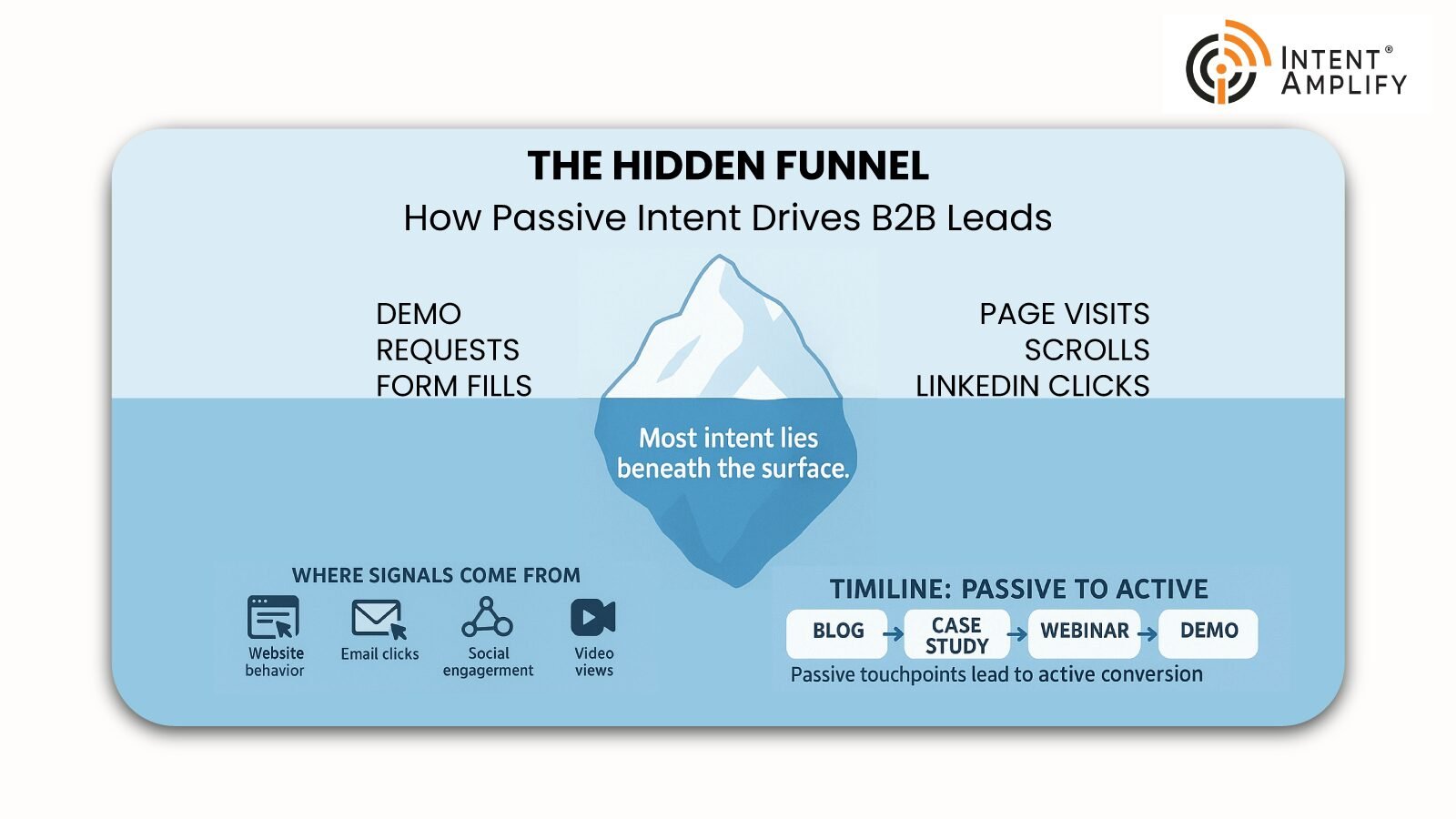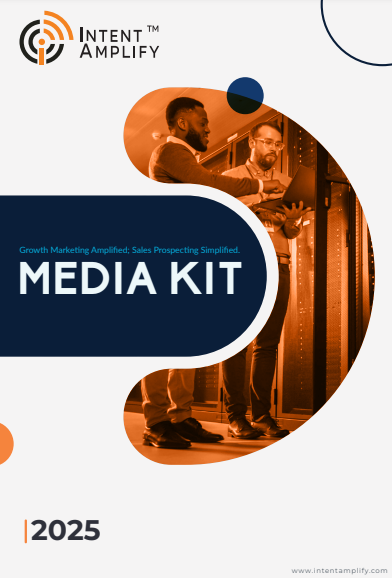
Why Passive Intent Matters More Than You Think in B2B Lead Gen
- Last updated on: July 17, 2025
The Hidden Clues That Drive True Conversions
In the no-holds-barred business of B2B lead generation, it’s all too tempting to get caught up in following the loudest signals. You know the kind when a lead downloads your new whitepaper, views your pricing page three times in seven, or completes a “Request a Demo” form. Those are shining moments in your CRM like a Christmas tree. And they should be those are definite indicators of active buying intent. But here’s something to consider: What if the best prospects are not the loudmouths, but the whisperers?
Now, don’t write that off as poetic nonsense. Here’s what you need to think about: In 2025, most of the B2B buying process happens long before a prospect ever engages with sales. Gartner reports that 83% of the buyer process is done before direct communication even starts with a vendor.¹ That’s not a small movement – that’s a seismic shift.
These “invisible buyers” are doing their research behind closed doors. They’re consuming product comparisons on third-party sites, bingeing on thought leadership on LinkedIn, or passively reading your blog without leaving a trace of their identity. This, my friend, is where passive intent lives.
So what exactly is passive intent, and why is it quickly becoming the most overlooked (and underutilized) asset in your B2B toolkit?
In this article, we’ll explore:
- What passive intent means in today’s 2025 B2B world
- Why it’s a game-changer when it comes to demand generation and account-based marketing
- How leading-performing sales and marketing teams are already leveraging it.
- Tools, tactics, and real-world templates you can apply instantly
And yes we’ll toss in a few clever visuals, some witty humor, and a healthy dose of surprising twists along the way. Because let’s be honest: B2B doesn’t have to be dull.
Ready to begin hearing the buying signals no one else is hearing?
Let’s get started.
What Is Passive Intent (and How It’s Different from Active Signals)?
Let’s be specific when we hear intent in B2B, our brains tend to go immediately to those “hot leads.” You know, the ones who downloaded a pricing sheet, asked for a demo, or tapped the big CTA that yells “Speak with Sales.”
That’s active intent. And yeah, it’s thrilling. It’s clear. It’s quantifiable.
But what of the customer who took 18 minutes to read your “Emerging Trends in Data Compliance” blog post twice? Or the IT director who watched your product demo on YouTube, stopped midway through, and came back the next day to pick it up where they left off? Or the procurement officer who is regularly visiting your resource center, clicking only ever on third-party risk-related content?
These aren’t flukes. These are passive intent signals silent, early, but intensely revealing.
Passive intent is different from active intent, when a buyer actively demonstrates interest in talking to you, which is obvious. Passive intent expresses interest in discovering about their issue, about their alternatives, and occasionally, about your category. It is the online body language of investigation, assessment, and inquiry.
And let’s be explicit: passive is not cold or uninterested. It usually means not yet prepared. And in the B2B marketplace of today, that’s an enormous segment of your actual audience.
The reality is, B2B buyers have changed. They’re more independent, more cynical, and better-equipped than ever before. Ten years ago, your salespeople may have been the first touchpoint. Today? Buyers show up with research, ratings, peer referrals, and comparisons against competitors, most of which occur far ahead of time before they reach your CRM.
In reality, according to a 2024 survey, 87% of B2B buyers like to self-serve their buying process, consuming content anonymously without talking to a vendor until they’re ready. That’s an astronomical figure. And it’s only increasing.
Now ask yourself: how many of your marketing campaigns, lead scoring models, or retargeting plans are being crafted for those buyers, the ones that have yet to make a move, but are leaving you digital breadcrumbs?
Passive intent gets confused with indecision. But in fact, it’s the basis for considerate, well-informed decision-making. And when you can catch and follow up on it early without being in-your-face, you have a huge edge: you arrive on the scene before your competitors even realize there is a deal on the table.
In short, passive intent is the science of seeing interest before it speaks.
And in 2025, that’s not an indulgence, it’s a requirement.
The Big Shift – Why Passive Intent Is the New Power Signal in 2025
Let’s go back for a second. There was a day when B2B marketing was a lead capture game. Gated content, forms, pop-ups marketers quantified success by the number of email addresses they could gather within a quarter. That strategy, effective in its time, just doesn’t get the job done anymore.
Why? Because B2B buyers have changed. Drastically.
In 2025, we’re living in an era where attention is scarce, skepticism is high, and most buying journeys happen outside the vendor’s visibility. The modern buyer doesn’t want to “book a demo” the moment they realize they have a problem. They want to explore. Quietly. On their terms.
Based on Gartner’s and McKinsey’s “Future of B2B Sales” research, 83% of the typical B2B purchasing decision is completed before a buyer directly interacts with a vendor.¹ In other words, by the time your sales team becomes involved, the prospect has already made up their mind, compared vendors against each other, and even possibly reduced their shortlist.
What does that imply for your lead generation efforts?
Waiting for active intent signals means being behind the curve.
And this is where passive intent becomes crystal clear. It’s not simply waiting for curiosity to be identified it’s about identifying and shaping decision-making before it fully forms. The sooner you can catch buyer interest, the sooner you can customize your messaging, educate responsibly, and shape the narrative.
And here’s the kicker: when you interact with prospects in the passive phase, you’re not playing against five other sellers. You’re creating mindshare when their choices are still unclear. You’re becoming part of their learning cycle, not another seller in the inbox.
Let’s put this into perspective. Let’s say you’re selling enterprise risk management software. By the time a prospect downloads your price sheet, they’ve probably interacted with 2–3 rivals. You’re already in a race.
But when you sense passive interest, e.g., repeat visits to your thought leadership pieces on “Decentralized Risk Assessment Models” or “AI for Compliance Audits,” you get to reach out to them discreetly, strategically, and with substance before your competition even knows they are in the game.
You arrive first. You teach rather than sell. And in the mind of the buyer, you are the default expert, not the desperate closer.
This early involvement also has another essential benefit: less noise, more relevance. Passive intent data shows what buyers are interested in, not what you wish they were interested in. That understanding makes your campaigns more intelligent, your outreach more tailored, and your sales conversations much better connected to true buyer pain points.
So if you’re still chasing form fills, consider this your wake-up call: the best buyers don’t fill out forms; they consume, evaluate, and shortlist silently.
And those who learn to decode this passive behavior? They don’t just generate leads. They generate loyalty.
Real Example – How Passive Intent Looks in Practice
Let’s take a scenario that might feel all too familiar. You’re the marketing head at a mid-size cybersecurity SaaS firm. Your team has been publishing a steady stream of blog content deep dives on ransomware mitigation, short explainers on data privacy laws, and a few webinars led by your product experts.
At first sight, your analytics dashboard is quiet. No spikes in form fills. No deluge of demo requests. No new SQLs in Salesforce. You may think… “It’s not working.”
But wait.
In the past three weeks, your intent data platform has noticed something interesting.
A few people from the same firm, a regional healthcare system based in Illinois, have been interacting with your content:
One read a blog post, “Why Mid-Sized Healthcare Firms Are the New Target of Cybercrime,” and lingered for five minutes on the page.
Another viewed 80% of a webinar titled “Zero Trust Architecture for HIPAA Compliance”.
A third surfed through your “Resources” page and clicked on two case studies from healthcare clients.
No one has filled out a contact form. But the behavior is yelling.
That, right there, is passive intent at work.
Now, suppose your sales team was alerted to this developing interest trend, not because one person had completed a form, but because several members of the same company are repeatedly engaging in relevant, sustained activity on different kinds of content.
At this juncture, what can you do?
You might:
Create a targeted LinkedIn campaign promoting value-driven content relevant to healthcare security issues.
Send a politely personalized outreach email to senior IT or compliance contacts at the business (without mentioning their activity), inviting them to an upcoming healthcare data protection roundtable.
Nurture them lightly with content such as “Healthcare Ransomware Trends 2025” or “Checklist: Evaluating Cloud Security Vendors for HIPAA.”
All of these interactions feel natural. Relevant. Useful. And most importantly, they’re not prompted by a cold call. They’re ignited by intentional behavior.
Here’s the kicker: when this company is ready to discuss vendors, you’ve already established trust. You’ve arrived early, educated them, and subtly placed your solution in their consideration process.
Now compare that with a competitor who waits until the demo request comes in. Who do you think is going to have the advantage?
Exactly. Passive intent is similar to seeing footprints in the snow. The majority of marketers wait for the knock at the door. However, if you can see where your prospects have gone before, you’ll know where they’re going before they even know it themselves.
How to Leverage and Use Passive Intent Data Effectively in 2025
Having an idea of passive intent is great doing something about it is a different story. But with strategy and tools on hand, following faint whispers from buyers to create great insights is within reach.
Let’s break it down to a lean, no-nonsense system.
Step 1: Get Equipped with the Right Tools
You can’t respond to these if you can’t detect them. Tools like Bombora, 6sense, and Leadfeeder appear to illuminate by detecting buying signals beyond your owned media, third-party content, visits from unknown sources, or topic-level searches on the entire web.
These tools help detect when companies are indeed researching your domain, before they ever reach your site.
Step 2: Follow the Right Signals
Passive intent emerges in patterns:
- Consistent returns to thought leadership or learning material
- A handful of viewers from the same firm are watching related material
- Co-browsing with ungated application software or webinars
- Conversations on LinkedIn with your brand material
- One event will be nothing, but a cluster of similar events will demonstrate traction.
Step 3: Score Behavior Contextually
Put more value on behavior that shows higher interest. One individual reading three blog posts in one solution space is a bigger opportunity than one individual, one time clicking on your home page.
Passive intent scoring is not quantitative it’s relevance and consistency over time.
Step 4: Respond with Value, Not Aggression
Don’t shoot over your head.
Refined, value-added follow-up is the path to winning. For instance:
- Send a relevant industry resource
- Retarget with awareness content, not a hard sell
- Invite decision-makers to a peer-focused event or roundtable
Remember: you’re nurturing curiosity, not closing a deal on day one.
Step 5: Align Sales and Marketing Around These Signals
Make passive intent transparent across teams. Trigger alerts when interest spikes from target accounts. Allow marketing to build nurture flows off of specific behavior patterns. Allow sales to leverage intent to prioritize their outreach with warmer leads. Learn how to Align Sales and Marketing. The highest-performing B2B teams of 2025 are not just responding to form fills; those teams are tracking intent like heat maps, and showing up early with insight, not intrusion.
Let’s be precise, most B2B buyers aren’t completing your forms anymore. But they aren’t not interested.
They are still researching, comparing, learning… just silently. This ’silent research’ is where passive intent becomes your unfair advantage.
By ‘tracking’ low-key signals like repeated visits, downloads of your content, or engagement on LinkedIn, you get a glimpse into their buying decision long before they contact you. And in 2025, that insight is invaluable.
This behavior isn’t spying it’s listening better. Understanding passive intent allows B2B teams to not just pursue leads but have ready buyers attracted to them, at the right time, with helpful touchpoints.
Trend: 66% of top-performing reps use data insights in every outreach, according to the Salesforce Report.
Recommended: The Future of B2B Lead Generation: Trends You Need to Know in 2025
Conclusion
In a world where buyers rarely raise their hands until they have almost closed (of course, asking for a demo after they’ve closed is akin to showing up after the movie is over), waiting around for a request for a demo is like waiting until the end credits after you’ve missed the movie. The gold mine exists in seeing the subtler signs – the scrolling of pages, viewing of webinar replays, repeat visits to your site, and that LinkedIn click at 9:47 PM on a Thursday.
The signs may not be loud, but they’re effective.
Passive intent isn’t just about the data. It’s about recognizing that modern buyers have different psychology, trying to provide your team the trigger to be ingrained early on, and realigning sales and marketing to build trust when your top competitor doesn’t even exist.
The trick is to move from being reactive to proactive. From being in pursuit of MQLs to inspiring curiosity before it hits necessity.
So, stop looking for hands up in the air, start listening for footsteps approaching.
FAQs
1. How is passive intent distinct from random browsing?
It’s all about patterns. One blog read could mean nothing. But if over a week, three people from the same company visit product pages or webinars – that’s passive buying interest.
2. When should sales engage with passive intent?
Once there are consistent patterns. Let marketing build the nurturing experience up until that point. After you have established multiple signs, sales can call in with a personalized, helpful connection, rather than a standard hard pitch.
3. Do I need a platform at a high cost to be able to leverage passive intent?
No. High-level platforms like 6sense, Bombora are powerful, but you can leverage passive intent with affordable tools, Leadfeeder, Clearbit, or LinkedIn analytics.
4. Does passive intent help smaller B2B teams?
Yes – or even more. If you’re penetrating, say, 50 accounts, knowing which 5 are showing the early signs can help you spend less, convert quicker.
5. How do I not creep prospects out?
Use intent data to inform strategy rather than individual stalking. Avoid the precise level of detail like, “We noticed you read X a3 pmpm.”Use the insights to provide relevant content and helpful nudging when necessary.





